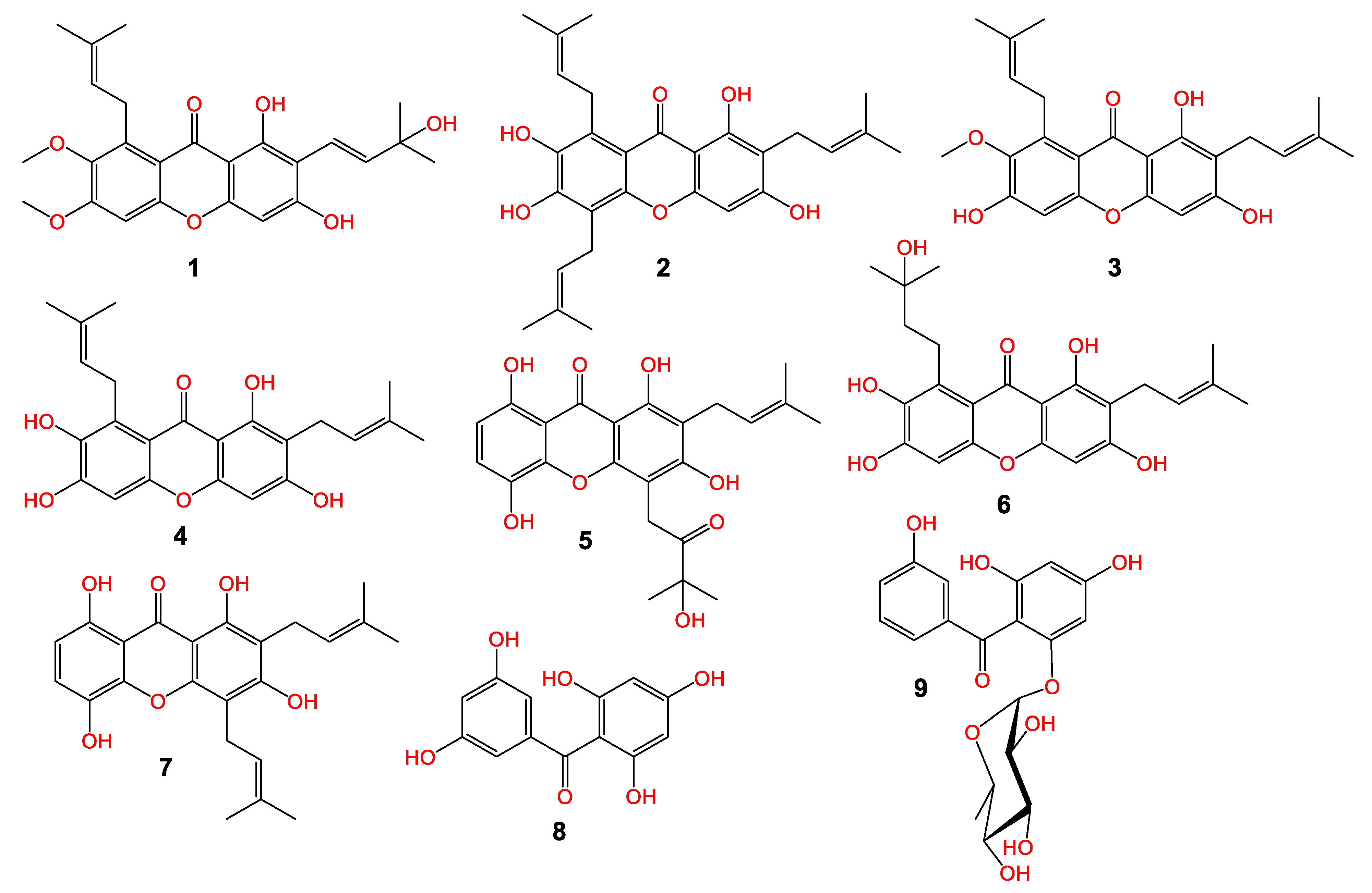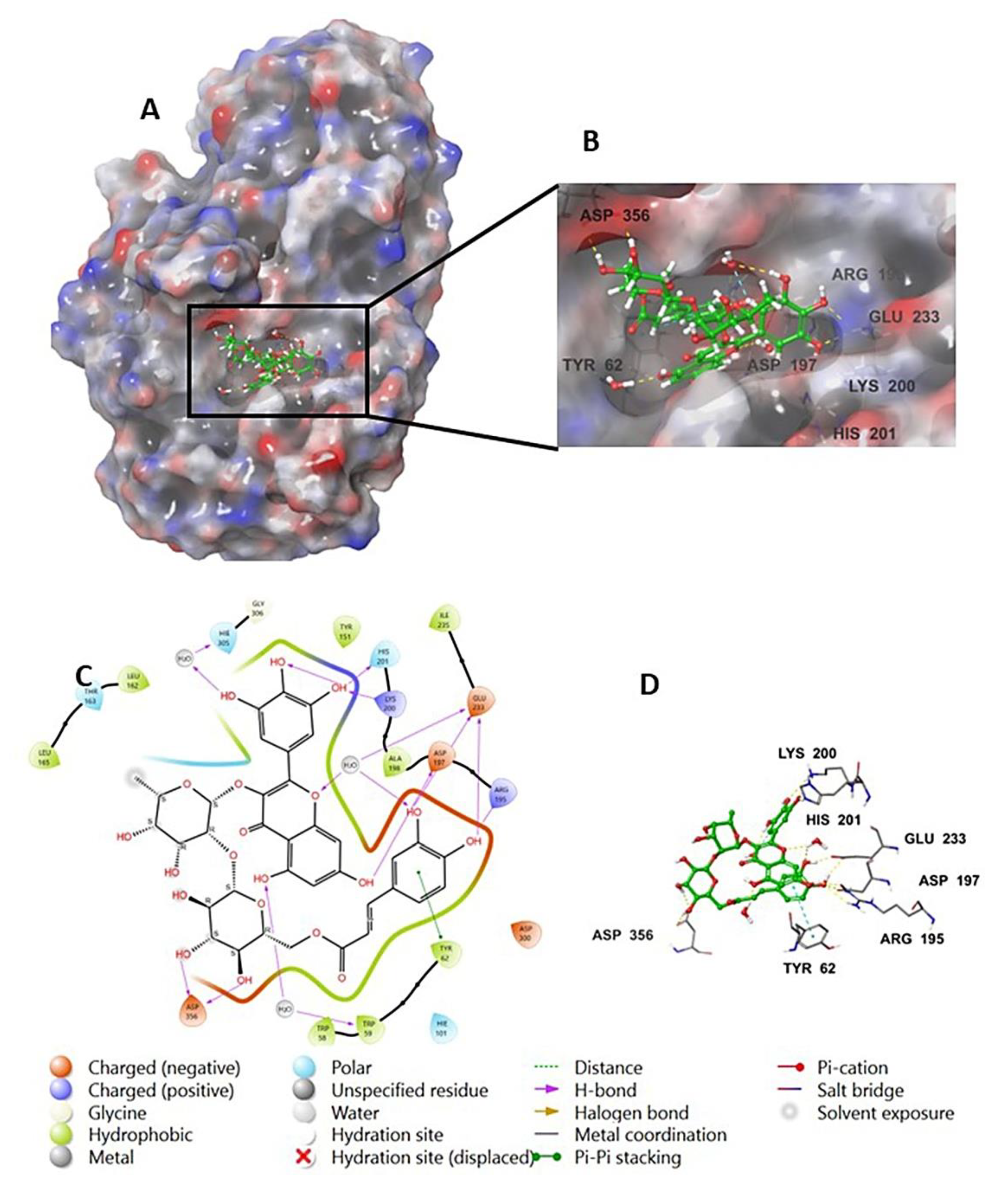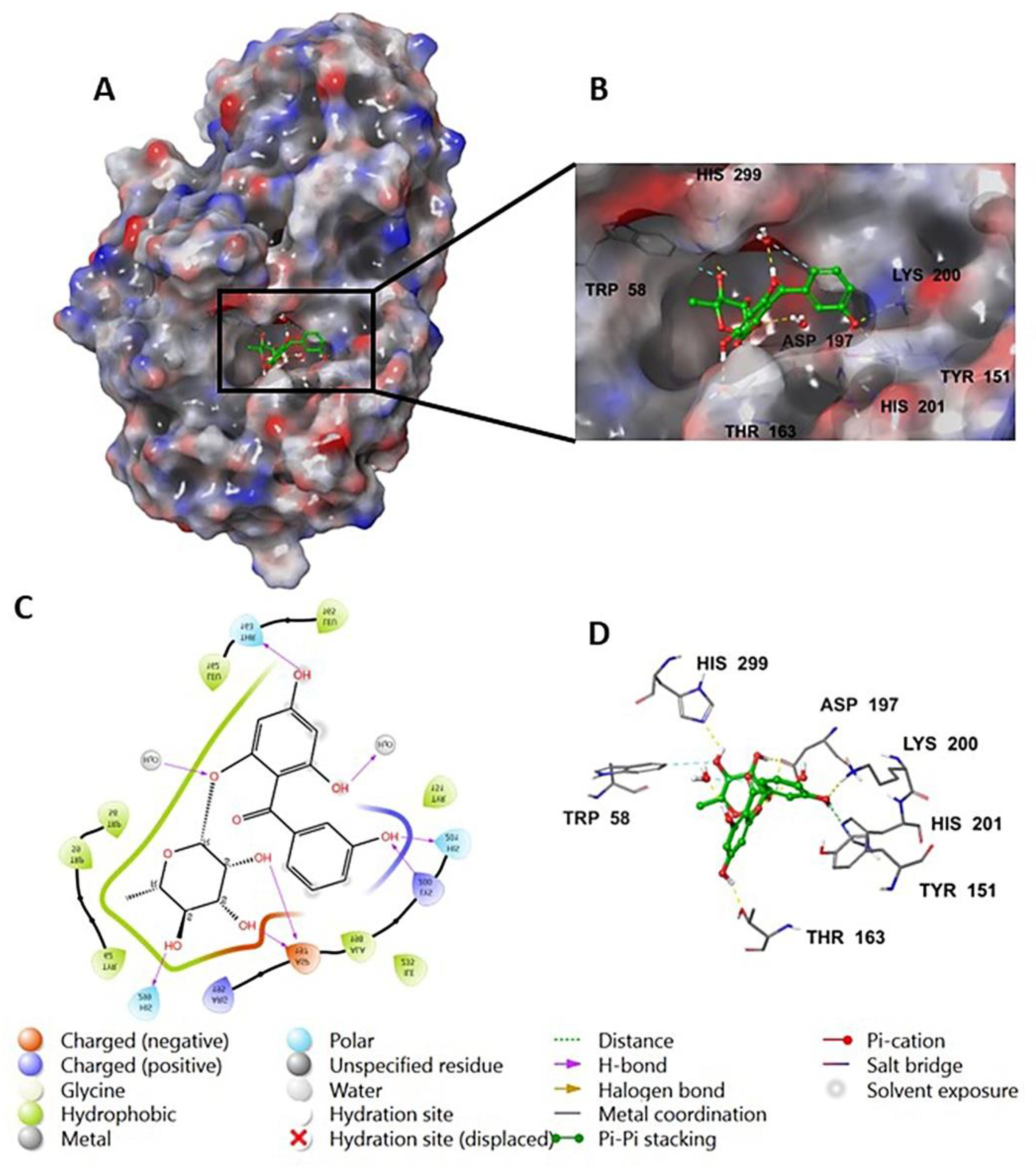Garcixanthone E and Garcimangophenone C: New Metabolites from Garcinia mangostana and Their Cytotoxic and Alpha Amylase Inhibitory Potential
Abstract
1. Introduction
2. Material and Methods
2.1. General Experimental Procedures
2.2. Plant Material
2.3. Extraction and Isolation
Spectral Data
2.4. In Vitro Cytotoxic Assay
2.5. a-Amylase Inhibitory Assay
2.6. Molecular Docking Evaluation
2.6.1. Protein Preparation
2.6.2. Ligand Preparation
2.6.3. Receptor Grid Generation and Docking
3. Results and Discussion
3.1. Metabolites Purification and Structural Determination of 1 and 9
3.2. Cytotoxic and AAI (Alpha-Amylase Inhibitory) Activities
3.3. Molecular Docking Evaluation
3.3.1. Ligands and Protein Preparation
3.3.2. Receptor Grid Generation and Molecular Docking Studies
4. Conclusions
Supplementary Materials
Author Contributions
Funding
Institutional Review Board Statement
Informed Consent Statement
Data Availability Statement
Acknowledgments
Conflicts of Interest
References
- Ovalle-Magallanes, B.; Eugenio-Pérez, D.; Pedraza-Chaverri, J. Medicinal properties of mangosteen (Garcinia mangostana L.): A comprehensive update. Food Chem. Toxicol. 2017, 109, 102–122. [Google Scholar] [CrossRef] [PubMed]
- Saraswathy, S.U.P.; Lalitha, L.C.P.; Rahim, S.; Gopinath, C.; Haleema, S.; SarojiniAmma, S.; Aboul-Enein, H.Y. A review on synthetic and pharmacological potential of compounds isolated from Garcinia mangostana Linn. Phytomedicine Plus 2022, 2, 100253. [Google Scholar] [CrossRef]
- Ghazali, S.A.I.S.M.; Lian, G.E.C.; Abd Ghani, K.D. Chemical constituent from roots of Garcinia mangostana (Linn.). Int. J. Chem. 2010, 2, 134. [Google Scholar]
- Obolskiy, D.; Pischel, I.; Siriwatanametanon, N.; Heinrich, M. Garcinia mangostana L.: A phytochemical and pharmacological review. Phytother. Res. 2009, 23, 1047–1065. [Google Scholar] [CrossRef]
- Pedraza-Chaverri, J.; Cárdenas-Rodríguez, N.; Orozco-Ibarra, M.; Pérez-Rojas, J.M. Medicinal properties of mangosteen (Garcinia mangostana). Food Chem. Toxicol. 2008, 46, 3227–3239. [Google Scholar] [CrossRef] [PubMed]
- Vien, L.C.; Chinnappan, S.; Mogana, R. Antioxidant activity of Garcinia mangostana L and alpha mangostin: A review. Res. J. Pharm. Technol. 2021, 14, 4466–4470. [Google Scholar] [CrossRef]
- Alhakamy, N.A.; Mohamed, G.A.; Fahmy, U.A.; Eid, B.G.; Ahmed, O.A.A.; Al-Rabia, M.W.; Khedr, A.I.M.; Nasrullah, M.Z.; Ibrahim, S.R.M. New Alpha-Amylase Inhibitory Metabolites from Pericarps of Garcinia Mangostana. Life 2022, 12, 384. [Google Scholar] [CrossRef]
- Mohamed, G.A.; Ibrahim, S.R. New Benzophenones and a Dihydroflavanonol from Garcinia Mangostana Pericarps and their Antioxidant and Cytotoxic Activities. Phytochem. Lett. 2020, 39, 43–48. [Google Scholar] [CrossRef]
- Ibrahim, S.R.M.; Abdallah, H.M.; El-Halawany, A.M.; Radwan, M.F.; Shehata, I.A.; Al-Harshany, E.M.; Zayed, M.F.; Mohamed, G.A. Garcixanthones B and C, New Xanthones from the Pericarps of Garcinia Mangostana and their Cytotoxic Activity. Phytochem. Lett. 2018, 25, 12–16. [Google Scholar] [CrossRef]
- Gul, S.; Aslam, K.; Pirzada, Q.; Rauf, A.; Khalil, A.A.; Semwal, P.; Bawazeer, S.; Al-Awthan, Y.S.; Bahattab, O.; Al-Duais, M.A.; et al. Xanthones: A class of heterocyclic compounds with anticancer potential. Curr. Top. Med. Chem. 2022, 10, 2174. [Google Scholar]
- Huang, Q.; Wang, Y.; Wu, H.; Yuan, M.; Zheng, C.; Xu, H. Xanthone glucosides: Isolation, bioactivity and synthesis. Molecules 2021, 26, 5575. [Google Scholar] [CrossRef] [PubMed]
- Surana, K.; Chaudhary, B.; Diwaker, M.; Sharma, S. Benzophenone: A Ubiquitous Scaffold in Medicinal Chemistry. MedChemComm 2018, 9, 1803–1817. [Google Scholar] [CrossRef] [PubMed]
- World Health Organization. Global Health Estimates 2020: Deaths by Cause, Age, Sex, by Country and by Region, 2000–2019; WHO: Geneva, Switzerland, 2020. [Google Scholar]
- Ferlay, J.; Colombet, M.; Soerjomataram, I.; Parkin, D.M.; Piñeros, M.; Znaor, A.; Bray, F. Cancer Statistics for the Year 2020: An Overview. Int. J. Cancer 2021, 149, 778–789. [Google Scholar] [CrossRef]
- Dutta, S.; Mahalanobish, S.; Saha, S.; Ghosh, S.; Sil, P.C. Natural Products: An Upcoming Therapeutic Approach to Cancer. Food Chem. Toxicol. 2019, 128, 240–255. [Google Scholar] [CrossRef] [PubMed]
- Cragg, G.M.; Grothaus, P.G.; Newman, D.J. Impact of Natural Products on Developing New Anti-Cancer Agents. Chem. Rev. 2009, 109, 3012–3043. [Google Scholar] [CrossRef]
- Reddy, L.; Odhav, B.; Bhoola, K.D. Natural Products for Cancer Prevention: A Global Perspective. Pharmacol. Ther. 2003, 99, 1–13. [Google Scholar] [CrossRef]
- Rajendra, G. Mehta, Genoveva Murillo, Rajesh Naithani & Xinjian Peng. Cancer Chemoprevention by Natural Products: How Far have We Come? Pharm. Res. 2010, 27, 950–961. [Google Scholar]
- Sastry, G.M.; Adzhigirey, M.; Day, T.; Annabhimoju, R.; Sherman, W. Protein and Ligand Preparation: Parameters, Protocols, and Influence on Virtual Screening Enrichments. J. Comput. Aided Mol. Des. 2013, 27, 221–234. [Google Scholar] [CrossRef]
- Schrödinger, L.L.C. Schrödinger Release 2021-4: LigPrep; Schrödinger, LLC: New York, NY, USA, 2021. [Google Scholar]
- Schrödinger, L.L.C. Schrödinger Release 2021-4: Glide; Schrödinger, LLC: New York, NY, USA, 2021. [Google Scholar]
- Sen, A.K.; Sarkar, K.K.; Mazumder, P.C.; Banerji, N.; Uusvuori, R.; Hase, T.A. The Structures of Garcinones a, B and C: Three New Xanthones from Garcinia Mangostana. Phytochemistry 1982, 21, 1747–1750. [Google Scholar] [CrossRef]
- Iwo, M.I.; Soemardji, A.A.; Hanafi, M. Sunscreen Activity of A-Mangostin from the Pericarps of Garcinia Mangostana. J. Appl. Pharm. Sci. 2013, 3, 70–73. [Google Scholar]
- Govindachari, T.R.; Kalyanaraman, P.S.; Muthukumaraswamy, N.; Pai, B.R. Xanthones of Garcinia Mangostana Linn. Tetrahedron 1971, 27, 3919–3926. [Google Scholar] [CrossRef]
- Bennett, G.J.; Lee, H.; Lee, L. Synthesis of Minor Xanthones from Garcinia Mangostana. J. Nat. Prod. 1990, 53, 1463–1470. [Google Scholar] [CrossRef]
- Ishiguro, K.; Nakajima, M.; Fukumoto, H.; Isoi, K. A Xanthone Substituted with an Irregular Monoterpene in Cell Suspension Cultures of Hypericum Patulum. Phytochemistry 1995, 39, 903–905. [Google Scholar] [CrossRef]
- Tanaka, N.; Kubota, T.; Kashiwada, Y.; Takaishi, Y.; Kobayashi, J. Petiolins F—I, Benzophenone Rhamnosides from Hypericum Pseudopetiolatum Var. Kiusianum. Chem. Pharm. Bull. 2009, 57, 1171–1173. [Google Scholar] [CrossRef][Green Version]
- Mekseepralard, C.; Areebambud, C.; Suksamrarn, S.; Jariyapongskul, A. Effects of Long-Term Alpha-Mangostin Supplementation on Hyperglycemia and Insulin Resistance in Type 2 Diabetic Rats Induced by High Fat Diet and Low Dose Streptozotocin. J. Med. Assoc. Thail. Chotmaihet Thangphaet 2015, 98, 23. [Google Scholar]
- Taher, M.; Zakaria, T.; Syafiq, T.M.F.; Susanti, D.; Zakaria, Z.A. Hypoglycaemic Activity of Ethanolic Extract of Garcinia Mangostana Linn. in Normoglycaemic and Streptozotocin-Induced Diabetic Rats. BMC Complement. Altern. Med. 2016, 16, 1–12. [Google Scholar] [CrossRef]
- Husen, S.A.; Kalqutny, S.H.; Ansori, A.N.M.; Susilo, R.J.K.; Alymahdy, A.D.; Winarni, D. Antioxidant and Antidiabetic Activity of Garcinia Mangostana L. Pericarp Extract in Streptozotocin-Induced Diabetic Mice. Biosci. Res. 2017, 14, 1238–1245. [Google Scholar]
- Karim, N.; Rahman, M.A.; Changlek, S.; Tangpong, J. Short-Time Administration of Xanthone from Garcinia Mangostana Fruit Pericarp Attenuates the Hepatotoxicity and Renotoxicity of Type II Diabetes Mice. J. Am. Coll. Nutr. 2020, 39, 501–510. [Google Scholar] [CrossRef]
- Janicka, P.; Płotka-Wasylka, J.; Jatkowska, N.; Chabowska, A.; Fares, M.Y.; Andruch, V.; Kaykhaii, M.; Gębicki, J. Trends in the New Generation of Green Solvents in Extraction Processes. Curr. Opin. Green Sustain. Chem. 2022, 37, 100670. [Google Scholar] [CrossRef]




| 1 * | 9 ** | ||||||
|---|---|---|---|---|---|---|---|
| No. | δH (mult., J (Hz) | δC (mult.) | HMBC | No. | δH [mult., (Hz)] | δC (mult.) | HMBC |
| 1 | 157.9 C | 1 | - | 109.4 C | - | ||
| 2 | 104.7 C | 2 | - | 161.7 C | - | ||
| 3 | 160.1 C | 3 | 6.06 d (2.0) | 98.1 CH | 1, 2, 4, 5, 7 | ||
| 4 | 6.23 s | 94.2 CH | 2, 3, 4a, 8b | 4 | - | 163.8 C | - |
| 4a | 156.7 C | 5 | 6.21 d (2.0) | 95.7 CH | 1, 2, 4, 3, 6, 7 | ||
| 4b | 154.7 C | 6 | - | 159.5 C | - | ||
| 5 | 6.88 s | 97.7 CH | 4b, 8a, 6, 7 | 7 | - | 197.5 C | - |
| 6 | 151.9 C | 1′ | - | 142.8 C | |||
| 7 | 142.6 C | 2′ | 7.11 d (1.8) | 116.9 CH | 1′, 3′, 4′, 6′, 7 | ||
| 8 | 137.0 C | 3′ | - | 158.2 C | - | ||
| 8a | 112.0 C | 4′ | 6.95 dd (7.8, 1.8) | 120.4 CH | 2′, 3′, 6′ | ||
| 8b | 103.5 C | 5′ | 7.19 d (7.8) | 130.2 CH | 1′, 2′, 3′, 4′, 7 | ||
| 9 | 182.2 C | 6′ | 7.17 dd (7.8, 1.8) | 121.4 CH | 1′, 2′, 3′, 4′, 7 | ||
| 1-OH | 13.71 s | - | 1, 8b | 1″ | 5.36 d (1.2) | 103.7 CH | 6 |
| 6-OCH3 | 3.81 s | 59.9 CH3 | 6 | 2″ | 3.82 m | 72.4 CH | 1″, 3″, 4″ |
| 7-OCH3 | 3.75 s | 61.5 CH3 | 7 | 3″ | 3.30 m | 72.6 CH | 1″, 5″ |
| 1′ | 6.72 d (15.4) | 115.8 CH | 2, 3, 2′, 3′, 4′, 5′ | 4″ | 3.26 m | 73.6 CH | 2″, 6″ |
| 2′ | 5.55 d (15.4) | 127.1 CH | 1, 2, 3′, 4′, 5′ | 5″ | 3.69 m | 71.0 CH | 2″, 3″, 6″ |
| 3′ | - | 77.7 C | - | 6″ | 1.20 d (6.8) | 17.4 CH3 | 3″, 4″, 5″ |
| 4′ | 1.46 s | 28.5 CH3 | 2′, 3′, 5′ | - | - | - | - |
| 5′ | 1.46 s | 28.5 CH3 | 2′, 3′, 4′ | - | - | - | - |
| 1″ | 4.07 d (6.0) | 26.5 CH2 | 7, 8, 8a, 2″, 3″ | - | - | - | - |
| 2″ | 5.25 tq (7.8, 1.8) | 123.1 CH | 8, 4″, 5″ | - | - | - | - |
| 3″ | - | 132.2 C | - | - | - | - | - |
| 4″ | 1.68 s | 25.6 CH3 | 2″, 3″ | - | - | - | - |
| 5″ | 1.82 s | 18.1 CH3 | 2″, 3″ | - | - | - | - |
| Compound | Docking Score | Glide Gscore | Glide Emodel |
|---|---|---|---|
| Native_5E0F (5J7) | −9.932 | −9.966 | −149.432 |
| 9 | −7.746 | −7.916 | −83.594 |
| 1 | −5.204 | −5.309 | −58.601 |
Publisher’s Note: MDPI stays neutral with regard to jurisdictional claims in published maps and institutional affiliations. |
© 2022 by the authors. Licensee MDPI, Basel, Switzerland. This article is an open access article distributed under the terms and conditions of the Creative Commons Attribution (CC BY) license (https://creativecommons.org/licenses/by/4.0/).
Share and Cite
Mohamed, G.A.; Ibrahim, S.R.M. Garcixanthone E and Garcimangophenone C: New Metabolites from Garcinia mangostana and Their Cytotoxic and Alpha Amylase Inhibitory Potential. Life 2022, 12, 1875. https://doi.org/10.3390/life12111875
Mohamed GA, Ibrahim SRM. Garcixanthone E and Garcimangophenone C: New Metabolites from Garcinia mangostana and Their Cytotoxic and Alpha Amylase Inhibitory Potential. Life. 2022; 12(11):1875. https://doi.org/10.3390/life12111875
Chicago/Turabian StyleMohamed, Gamal A., and Sabrin R. M. Ibrahim. 2022. "Garcixanthone E and Garcimangophenone C: New Metabolites from Garcinia mangostana and Their Cytotoxic and Alpha Amylase Inhibitory Potential" Life 12, no. 11: 1875. https://doi.org/10.3390/life12111875
APA StyleMohamed, G. A., & Ibrahim, S. R. M. (2022). Garcixanthone E and Garcimangophenone C: New Metabolites from Garcinia mangostana and Their Cytotoxic and Alpha Amylase Inhibitory Potential. Life, 12(11), 1875. https://doi.org/10.3390/life12111875







